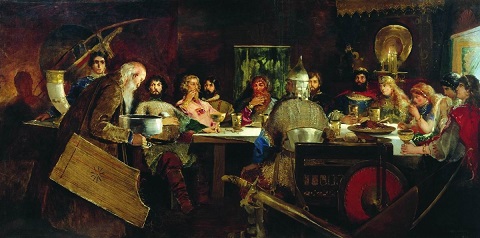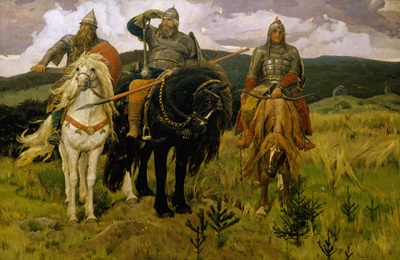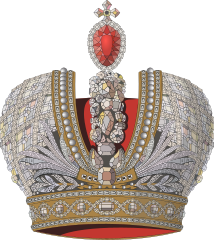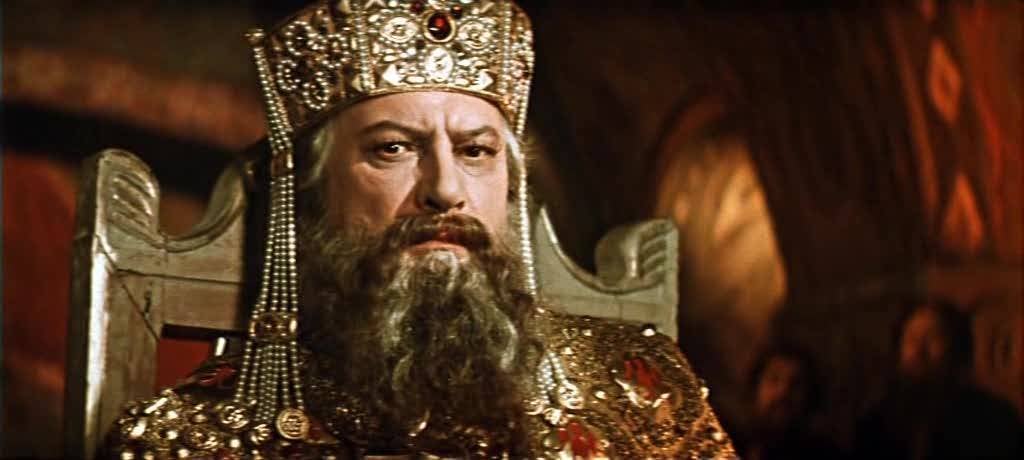
A P Ryabushkin, “Heroes feast with kind Prince Vladimir”.
Unlike parts one and two of Vladimir’s life; this time, we’ll be briefly looking at Prince Vladimir as the one of the central characters in Russian epic poetry, Vladimir Krasnoye Solnyshko (Red Sun, or more correctly, given the age of the poetry – Beautiful Sun). Russian epic poetry has become known by the term “былины / byliny” although the performers generally called the poems “stariny / старины” i.e. old stories, tales of old things. The tales, both spoken and sung, were collected from 18th century onwards, primarily in northern areas of Russia. These have been studied, analysed, grouped by topic, age, style and the area the stories are believed to have originated. Those concerning Vladimir are considered the Kievan Cycle of stories.
As with any subject of study, there is no complete agreement, but in general, it is considered that the Kievan Cycle was developed first in the south, from a tradition of bards whose job it was to compose poems / songs in praise of their noble employers. The first half of the 13th century saw the invasion of the Roman Empire by the Venetians in the Fourth Crusade and the Mongol invasion of Russia with the destruction of Kiev, coming on the heels of the loss of the Anatolian heartland of the Roman Empire to the Turks at the end of the 11th century and the development of trade routes that by-passed Constantinople in the 12th centuries as a result of the first three Crusades. All these factors fed into a situation where the centre of gravity for the Russian economy and state moved from the south around Kiev, to the north around Novgorod and Vladimir. The bards who had worked for southern warriors moved north and brought with them the songs of praise for local heroes which developed into a northern folk tradition, bringing in other themes and stories from later history as well as local tales.
Although it is widely considered that the Prince Vladimir the Red Sun of the epics is primarily based on the character of Saint Vladimir Svyatoslavich, there is the possibility he is a combination, including Vladimir Monomakh. For one thing, the bylinas give Vladimir’s patronymic as Vseslavich, or Seslavich, combining the first part of Vladimir Monomakh’s patronymic (Vsevolodich) and the second part of Saint Vladimir’s. Both men had married princesses from the Roman Empire (Anna in the case of Vladimir I and Euphemia for Vladimir II) and in the bylinas, the wife of Vladimir the Red Sun was a Greek princess called Eupraxia.
As is the case with many of the tales of King Arthur, the court of Prince Vladimir is merely the stage on which the tale of the real hero of the given tale starts. Vladimir the Red Sun is not himself a warrior; he is the generous lord who feeds his warriors, but who, in return leaves the dangerous work up to them. The real heroes of the stories are the “bogatyrs”, a word from a Turkic language and meaning “hero”, that was applied to the mounted warriors of the Grand Prince of Kiev’s warband.

Bogatyrs, V Vasnetsov.
Many of the characters of the bogatyrs are also believed to be based on real people, for example, Dobrynya Nikitich is inspired by Vladimir I’s uncle Dobrynya, Alyosha Popovich is based on an Aleksandr Popovich from Rostov, but the real man served a later Prince of Vladimir around 1200. The final character in the painting above is Ilya Muromets, Ilya was in real life a 12th century warrior, who became a monk in the Monastery of the Caves in Kiev and finally a saint. His relics remain in the monastery to this day (as do those of Nestor, the compiler of the Povest’ Vremennykh Let).
There are debates as to why – maybe because they reflect the actual nature of Vladimir himself, or that of later rulers, or because the tales are intended to praise the heroism of the bogatyrs involved, not the Grand Prince – but often Vladimir the Red Sun is shown in a less than flattering light. For one thing, unlike Vladimir Svyatoslavich, his epic equivalent is not keen to take his enemies on in battle, instead sending out the bogatyrs to do his dirty work. It has been suggested that this is because the Kievan Cycle of tales was created for the entertainment of later warriors – other, Princely, epic poems were more obviously composed for the glorification of Princes and do not have this dichotomy between heroic warriors and a more passive Prince.
Another aspect of Vladimir the Red Sun’s character is his delight in feasting and especially drinking. Given that Vladimir Svyatoslavich was famous for his feasts and generosity in food and drink to, not only his warriors, but also the people of Kiev, this might be something based on the original, rather than made up for dramatic effect. However, it seems that the character of Vladimir is generally that of a neutral canvas on which to paint the greater character of the hero. Sometimes the hero needs to overcome a ruler’s greed – then Vladimir is greedy. Sometimes the bogatyr needs to demonstrate his honesty against a background of betrayal, in which case Vladimir is treacherous.
In short, the figure of Vladimir the Red Sun, although clearly inspired, at least in part, by that of Vladimir Svyatoslavich, cannot be taken as a guide to the true character of the historical figure. However, the bylinas of Russia are worth exploring for their own sake, as a taste of mediaeval culture, with themes that might even date back to before the conversion to Christianity.
For Russian speakers wanting a deeper dive, I would suggest taking a look at this site: https://byliny.narod.ru/ by Aleksey Lel’chuk. He gives a guide to the byliny of the Kievan Cycle, including maps of the partially imaginary world they take place in, and has even re-written the byliny in modern Russian, available for free download. For non-Russian speakers, you can go straight to the download here: https://byliny.narod.ru/download/byliny.rar, copy and paste it into a machine translator and Bob’s your uncle. Google Translate changed “сыра земля” into “of the cheese, the earth”, rather than “the damp earth”, but you can’t have everything.
Another interesting introduction can be found here: https://arzamas.academy/courses/14. Again, this is in Russian, but using Microsoft Edge, Google Chrome, or probably many other browsers I’m not in an immediate position to check, right clicking and choosing Translate to English, you can get all the lovely information in English or a passable attempt at it or any other language they offer.
A recent set of cartoons have been made based loosely on the Kievan Cycle, they have been put up on Youtube here: https://www.youtube.com/user/TriBogatirya, while an earlier (1956) film about the tales of Ilya Muromets can be found here: https://www.youtube.com/watch?v=uopfqauEz64.
It isn’t based on a Kievan Cycle tale, but it is a very good recent film based on the bylina The Tale of the Destruction of Ryazan: Legenda o Kolovrate, or in English release (and watchable here in full, with English subtitles): Furious.
After this little break from history next time, we have Vladimir’s son, Svyatopolk the Accursed. Find out why he was so called in a week or two!


Leave a comment